WPF:如何高速更新Model中的属性
原文:[WPF/MVVM] How to deal with fast changing properties
In this article, I will describe a problem which happens in a WPF/MVVM application when the Model is updated at a very high frequency.
It happened to me while implementing a Model handling a lot of values coming from instruments and I wanted to display the current values, even if they were changing very quickly.
The test case
All my test are based on this simple Model class:
public class Model
{
const long MAX_DURATION = 20000;
public double Progress { get; private set; }
public event EventHandler<double> ProgressChanged;
public double Frequency { get; private set; }
public event EventHandler<double> FrequencyChanged;
public Model()
{
Task.Run((Action)LongRunningBackgroundTask);
}
void LongRunningBackgroundTask()
{
long loopCount = 0;
long elapsed = 0;
var chrono = new Stopwatch();
chrono.Start();
while (elapsed < MAX_DURATION)
{
elapsed = chrono.ElapsedMilliseconds;
SetProgress(100.0 * elapsed / MAX_DURATION);
SetFrequency(1.0 * loopCount / elapsed);
loopCount++;
}
}
void SetProgress(double value)
{
Progress = value;
if (ProgressChanged != null)
ProgressChanged(this, value);
}
void SetFrequency(double value)
{
Frequency = value;
if (FrequencyChanged != null)
FrequencyChanged(this, value);
}
}
As you can see, it’s very straightforward. The Model class contains two public properties Progressand Frequency and their associated events. During 20 seconds, it runs a loop in a background task and updates the properties as fast as it can:
Progresswill go from0.0to100.0.Frequencywill contains the average loop frequency so far.
The problem with the classic MVVM approach
In the classic MVVM approach, the ViewModel is attached to the Model’s events, so as to be updated on every change.
Usually, the ViewModel’s event handler calls Dispatcher.BeginInvoke() to ensure the eventPropertyChanged is raised in the UI thread.
public ViewModel()
{
dispatcher = Dispatcher.CurrentDispatcher;
model = new Model();
model.ProgressChanged += OnModelProgressChanged;
// ... then the same for the Frequency
}
void OnModelProgressChanged(double newValue)
{
dispatcher.BeginInvoke((Action)delegate() { Progress = newValue; });
}
public double Progress
{
get { return progress; }
set
{
if( progress == value ) return;
progress = value;
RaisePropertyChanged("Progress");
}
}
// ... then the same pattern for the Frequency property
However, this approach wont be able to work with the Model class defined earlier. The GUI is completely frozen and sometimes even throws an OutOfMemoryException.
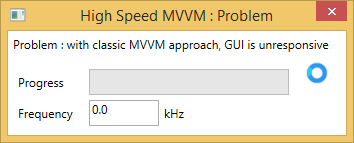
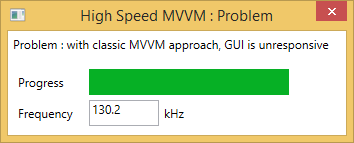
Here is why: Each time a Model’s property changes, the ViewModel calls BeginInvoke() and therefore appends a message in the dispatcher’s event queue. But the messages are dequeued way slower than they are added, so the queue will grow over and over until the memory is full.
Also, you can see that the execution speed of the Model’s task is really affected : only 130 kHz on average.
Solution 1 : Ignore events that are too close
The first solution that usualy comes in mind is:
Hmmm… I get too many events…
I’ll just slow them down !
OK, let’s try…
public ViewModel()
{
var dispatcher = Dispatcher.CurrentDispatcher;
var model = new Model();
Observable.FromEventPattern<double>(model, "ProgressChanged")
.Sample(TimeSpan.FromMilliseconds(5))
.ObserveOn(dispatcher)
.Subscribe(x => Progress = x.EventArgs);
}
Here, I used Reactive Framework because it offers the Sample() method which limits the rate of the events.
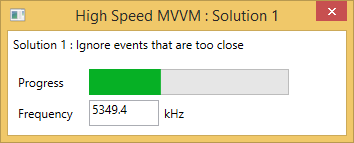
In this case the GUI is perfectly responsive and the Task execution speed is better but still low.
I think it’s a viable if you already use Reactive Framework, but I wouldn’t use it in my project: it’s too complicated and the performance is not good enough.
Solution 2 : Poll with a DispatcherTimer
Let’s look a this problem from a different angle. Why don’t we loose the “push” approach and use “pull” approach instead ?
In other words, instead of attaching to the event of the Model, the ViewModel could periodically read the values.
The most common way to implement polling in MVVM is to instanciate a DispatcherTimer in the ViewModel.
public ViewModel()
{
model = new Model();
var timer = new DispatcherTimer();
timer.Interval = TimeSpan.FromMilliseconds(5);
timer.Tick += OnTimerTick;
timer.Start();
}
void OnTimerTick(object sender, EventArgs e)
{
Progress = model.Progress;
Frequency = model.Frequency;
}
// ...the remaining is identical to the original ViewModel
Here you go ! No only the GUI is perfectly responsive, the execution speed of the Task is way better: 10 MHz
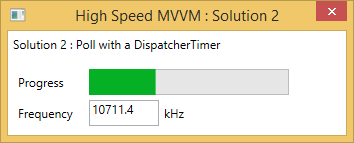
Solution 3 : Poll on CompositionTarget.Rendering
To make it even simpler, we can move the timer from the ViewModel to the View. From that place, we can use the CompositionTarget.Rendering event and completely get rid of the DispatcherTimer. (As a reminder this event is raised by WPF each time an animation frame is rendered, 30 or 60 times per seconds)
View’s code behind:
public MainWindow()
{
InitializeComponent();
DataContext = new ViewModel();
CompositionTarget.Rendering += OnRendering;
}
void OnRendering(object sender, EventArgs e)
{
if (DataContext is IRefresh)
((IRefresh)DataContext).Refresh();
}
ViewModel:
class ViewModel : INotifyPropertyChanged, IRefresh
{
public ViewModel()
{
model = new Model();
}
public void Refresh()
{
Progress = model.Progress;
Frequency = model.Frequency;
}
// ...the remaining is identical to the original ViewModel
}
You get almost the same result as Solution 1, and even a slightly faster execution speed.
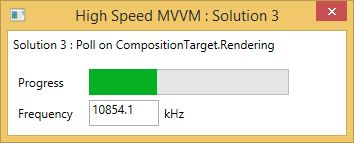
Conclusion
I like simple solutions, that why I really prefer the last one.
Whether it respects or not the MVVM pattern is really a matter of opinion. I really like the idea of theView being responsible of the timer logic and the ViewModel being responsible of updating its value.
One thing I really appreciate on the polling approach is that it really decouples the Model’s and theViewModel’s execution threads. We can even get rid of the Model’s events.
To conclude, here is a comparison of the memory consumptions: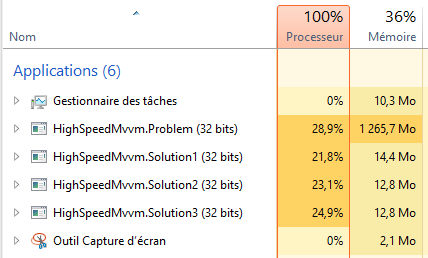
PS: A word about concurrency
When using the polling technique, you should take a special care of the concurrency.
Since the properties of the Model are accessed from several threads, you may need to add lock blocks if the type is bigger than a processor word (in my examples I used a int so that’s OK).
If you have a lot of changing properties in your model, you should group them in a class, likeModelState. That way, the ViewModel will only have one property to monitor and only this class needs to be thread safe.
WPF:如何高速更新Model中的属性的更多相关文章
- 在Asp.Net MVC中实现RequiredIf标签对Model中的属性进行验证
在Asp.Net MVC中可以用继承ValidationAttribute的方式,自定制实现RequiredIf标签对Model中的属性进行验证 具体场景为:某一属性是否允许为null的验证,要根据另 ...
- CompareValues标签对Model中的属性进行验证
在Asp.Net MVC中实现CompareValues标签对Model中的属性进行验证 在Asp.Net MVC中可以用继承ValidationAttribute的方式,自定制实现Model两个 ...
- 在.Net MVC中自定义ValidationAttribute标签对Model中的属性做验证
写一个继承与ValidationAttribute类的自定义的验证方法 MVC中传递数据时,大多数都会用Model承载数据,并且在传到控制器后,对Model进行一系列的验证. 我平时经常使用的判断方法 ...
- 将DataRow赋值给model中同名属性
/// <summary> /// 将DataRow赋值给model中同名属性 /// </summary> /// <typeparam name="T&qu ...
- MVVM Light 新手入门(2) :ViewModel / Model 中定义“属性” ,并在View中调用
今天学习MVVM架构中“属性”的添加并调用,特记录如下,学习资料均来自于网络,特别感谢翁智华的利刃 MVVMLight系列. 一个窗口的基本模型如下: View(视图) -> ViewModel ...
- 在Asp.Net MVC中实现CompareValues标签对Model中的属性进行验证
在Asp.Net MVC中可以用继承ValidationAttribute的方式,自定制实现Model两个中两个属性值的比较验证 具体应用场景为:要对两个属性值的大小进行验证 代码如下所示: /// ...
- iOS开发之遍历Model类的属性并完善使用Runtime给Model类赋值
在上篇博客<iOS开发之使用Runtime给Model类赋值>中介绍了如何使用运行时在实体类的基类中添加给实体类的属性赋值的方法,这个方法的前提是字典的Key必须和实体类的Property ...
- Model中的验证规则
一.能够使用Model的Attribute进行服务端数据验证 本文目录 一.概述 二.MVC提供的常用上下文 三.自定义正则表达式验证 一.概述 为了确保数据的安全性,由Client发送到服务端的每一 ...
- Js和Thymeleaf如何获取model中的值
一.Jquery获取Model中的数据 1.将model中的值赋给hidden,然后Js获取隐藏域的值. 后台的实现: @RequestMapping("/QEditorMod1" ...
随机推荐
- 广联达 BIM5D 云平台---《建筑信息模型标准》解读
广联达 BIM5D 云平台: 1.用户管理: https://account.glodon.com/info 2.模型使用: http://bim5d-hunan.glodon.com/api/v ...
- 纪念一下我对Kalman的无限崇拜之情
今天用Kalman来求线性预测模型的系数,和LMS一对比,天啦噜,我感叹了半小时... 和LMS需要选合适的步长,样本序列需要足够长,迭代次数需要足够多,相比,卡尔曼真是帅呆了!不需要步长!不需要蒙特 ...
- 发布自己的类库到NuGet
NuGet是一个为大家所熟知的Visual Studio扩展,通过这个扩展,开发人员可以非常方便地在Visual Studio中安装或更新项目中所需要的第三方组件,同时也可以通过NuGet来安装一些V ...
- apache做反向代理服务器
apache代理分为正向代理和反向代理: 1 正向代理: 客户端无法直接访问外部的web,需要在客户端所在的网络内架设一台代理服务器,客户端通过代理服务器访问外部的web(需要在客户端的浏览器中设置代 ...
- slice的部分说明
1.slice是数值的一个引用,并不会新增内存地址. 2.slice的容量和长度是两个概念,这个长度跟数组的长度是一个概念,即在内存中进行了初始化实际存在的元素的个数.何谓容量?如果通过make函数创 ...
- 003_crlf注入漏洞
一. (1) 线上收到一个crlf 注入的漏洞. 同时启用80和443才会暴露,配置如下: server { listen 80; listen 443 ssl; server_name www.jy ...
- Laravel 5.2数据库--多个关联关系,带条件约束的渴求式加载的问题
### 今天在连表获取数据的时候,老是获取不到想要的,确实有点无力适从的感觉. 归根到底,还是对laravel不够熟悉,至少是数据库操作那块. ### 问题是这样的: 我想要通过连表中间表,拿中间表的 ...
- 自定义admin(self_admin)
admin.site.register(models.UserInfo)admin.site.register(models.Book,Book_admin)######当下面注册的这个表里面没有这个 ...
- JsonResponse
1.JsonResponse class JsonResponse(data, encoder=DjangoJSONEncoder, safe=True, json_dumps_params=None ...
- Windows&Word 常用快捷键
Win:显示开始菜单 Win + E:打开文件管理器 Win + D:显示桌面 Win + L:锁定计算机 Win + I:打开设置 Win + M:最小化所有窗口 Alt + F4:1.用来关闭当前 ...
